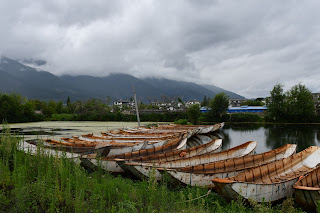Baizu Cheese and Baizu Tea
The second
day in Dali was just as rainy as the first, but this did not stop a full
program of events. While most people were making traditional Baizu tie-dye cloths,
a smaller group of us toured three temples in the town of Xizhou – a Taoist
temple, a Buddhist temple, and a Benzhu temple (that is, a temple to the deities
worshipped by the Bai people). Seeing statues of the Jade Emperor, the Bodhisattva
Guanyin, and gods with various animal paraphernalia brought back many memories
of reading the Journey to the West. One of the interesting things I learned
about the local religion is that the Bai people regard Kublai Khan as a deity
for sparing the local populace of the Mongols’ usual massacres.
Rice fields in Xizhou
Local house gate detail - notice again the emphasis on white
A toothy guardian above the gate
Elephant pillar at a local Taoist temple
Note the white walls and simplicity of the Baizu Taoist temple.
An extremely rare mural of Chairman Mao and Lin Biao, a Marshal of the People's Republic of China who fell out of favour in the early 1970s
A bamboo painting at a local Benzhu temple
The ornate entrance of a local house
Peacock detail above a door
After
touring the temples, our group rejoined the tie-dye group for lunch. I was
introduced to a new type of cheese called rushan (literally ‘milk fan’), another
specialty of the Bai people. According to my understanding, it is usually
served in very thin grilled slices, and in texture and flavour rather resembles
haloumi. We were also introduced to the Bai tradition of the three-course tea
toast, a custom meant to reflect what the Bai consider the three main stages of
life. The first cup of tea is bitter, meant to reflect the hardships of youth.
The second cup is very sweet, with pieces of rushan and walnut kernel mixed in.
It symbolises the happiness of married life. The final cup is also sweet, but is
not as mellow as the second: it contains ginger, cassia, and Sichuan pepper. Nicknamed
huiwei cha (or ‘reflection tea), it has a strong, almost salty aftertaste – it is
meant to resemble the reminiscences of old age.
We split
again after tea, with some of us cooking some local food whose name I can’t
remember and my group taking part in a jiama workshop – a type of Chinese woodcut.
As I learned, making woodcuts is not as easy as it seems. Putting just the
right amount of ink at just the right angle onto the woodblock is a science, one
that I comprehend as little as I comprehend most sciences.
After
jiama, we had two hours of free time in Xizhou before returning to Dali. I spent
them wandering off the beaten path, making my way towards the banks of the
Erhai on dirt roads to the evident consternation and bemusement of locals.
Having gotten to a touristy vantage point on a small peninsula jutting into the
lake just thirty minutes before our scheduled departure, I hailed an open cab
that drove me all the way back over roads so bumpy that at one point, the
driver asked me to get out of the car as the machine huffed and puffed over a
dirt hill spread across the road. I made it exactly in time.
A local opera stage design
Blue dragon on white wall at the opera building
Boats at Erhai
Clouds above Erhai
Erhai kayakers
Abandoned structures on the Erhai
Abandoned boats on the Erhai
Fisherman and fisherwoman spreading nets
A huge field of flowers I have not yet identified
A horse surprised to see tourists
Clouds in the mountains
I am not sure what this means
Another picture of Erhai
The last picture of Erhai, I swear




























Comments
Post a Comment